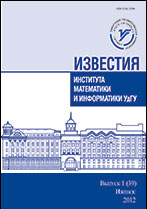|
|
Izvestiya Instituta Matematiki i Informatiki Udmurtskogo Gosudarstvennogo Universiteta, 2014, Issue 1(43), Pages 49–67
(Mi iimi290)
|
 |
|
 |
This article is cited in 1 scientific paper (total in 1 paper)
On solution of one optimization problem generated by simplest heat conduction equation
V. I. Rodionov
Udmurt State University, ul. Universitetskaya, 1, Izhevsk, 426034, Russia
Abstract:
The solution of boundary value problem for the simplest heat conduction equation defined on a rectangle can be represented as the sum of two terms which are solutions of two boundary value problems: in the first case, the boundary functions are linear, while in the second case, the initial function is zero. This specificity allows us to apply two-dimensional splines for the numerical solution of both problems. The first problem was studied in previous papers where an economical algorithm was obtained for its numerical solution with linear computational complexity. This fact served as the basis for similar constructions in solving the second problem. Here we also define the finite-dimensional space of splines of Lagrangian type, and as a solution, we suggest the optimal spline giving the smallest residual. We have obtained exact formulas for the coefficients of this spline and its residual. The formula for the spline coefficients is a linear form of initial finite differences on the boundary. The formula for the residual is the sum of five simple terms and a negative definite quadratic form of new finite differences defined on the boundary. The entries of the matrix of the form are expressed through Chebyshev's polynomials, the matrix is invertible and is such that the inverse matrix has a tridiagonal form. This feature allows us to obtain upper and lower bounds for the spectrum of the matrix and to show that the residual is bounded by a constant independent of the dimension $N$. It is shown that the associated residual tends to zero with increasing $N$. Thus, the obtained optimal spline should be considered the pseudosolution of the second problem.
Keywords:
heat conduction equation, interpolation, approximate spline, tridiagonal matrix, Chebyshev's polynomials.
Received: 17.10.2013
Citation:
V. I. Rodionov, “On solution of one optimization problem generated by simplest heat conduction equation”, Izv. IMI UdGU, 2014, no. 1(43), 49–67
Linking options:
https://www.mathnet.ru/eng/iimi290 https://www.mathnet.ru/eng/iimi/y2014/i1/p49
|

| Statistics & downloads: |
| Abstract page: | 233 | | Full-text PDF : | 67 | | References: | 42 |
|




 Contact us:
Contact us: Terms of Use
Terms of Use
 Registration to the website
Registration to the website Logotypes
Logotypes








 Citation in format
Citation in format 
